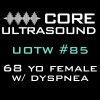A 56 year old male is brought in by paramedics complaining of generalized abdominal pain and distension. He is 1 week status-post operative colonic resection and anastomosis. His vitals are a temperature of 38.5C, pulse of 115, blood pressure of 95/65, respiratory rate of 32, and saturations of 94% on room air. Bedside ultrasound shows the following:

Answer and Pearl: Pneumoperitoneum (Anastomosis Breakdown)
The images demonstrate pneumoperitoneum (intraperitoneal free air) and complex free fluid due to anastomosis breakdown. The ability to diagnose pneumoperitoneum has traditionally been considered a weakness of ultrasound, but this is not the case. Here pneumoperitoneum was diagnosed at the bedside approximately 20 minutes before radiologic plain films were completed.
- The primary sonographic finding of pneumoperitoneum is the peritoneal stripe sign.1 This is a type of reverberation artifact with multiple reflections of the parietal peritoneum, similar to pleural A Lines.2
- Intraperitoneal free air will cast a dirty shadow and obscure the visualization of the deeper abdominal organs or appear as small hyperechoic foci of air bubblies within intraperitoneal free fluid.3
- High yield locations to detect pneumoperitoneum are the right hypochondrium and epigastric area with the patient supine and their thorax slightly elevated.1 Detection of free air may be increased by using the linear probe (10-12Hz) or by placing the patient in a left lateral position and observing the air shift to the least dependent area. Also, the Scissors Maneuver can be
 completed, where free air is intentionally displaced with probe pressure and then allowed to rapidly re-accumulate on release.4
completed, where free air is intentionally displaced with probe pressure and then allowed to rapidly re-accumulate on release.4 - False positives for pneumoperitoneum include basal lung, physiologic bowel gas, subcutaneous emphysema, and Chilaiditi Syndrome (bowel interposed between liver and diaphragm).1
- Ultrasound has a diagnostic accuracy for pneumoperitoneum superior to plain radiographs with a sensitivity of 95.5% and specificity of 81.8% in one recent study.5 However, large trials are lacking.
 If you like the ultrasound education you get from UOTW, you will absolutely love CastleFest, a world class ultrasound event held in April. Whether you’re an ultrasound novice or want to hone your experienced skills, come eat, drink and learn with the best educators in the field: Dawson, Mallin, Weingart, Mallemat, and more. Oh, and I’ll be there too. Register now.
If you like the ultrasound education you get from UOTW, you will absolutely love CastleFest, a world class ultrasound event held in April. Whether you’re an ultrasound novice or want to hone your experienced skills, come eat, drink and learn with the best educators in the field: Dawson, Mallin, Weingart, Mallemat, and more. Oh, and I’ll be there too. Register now.
- Hoffmann B, Nürnberg D, Westergaard MC. Focus on abnormal air: diagnostic ultrasonography for the acute abdomen. European journal of emergency medicine : official journal of the European Society for Emergency Medicine. 19(5):284-91. 2012. [pubmed]
- Lichtenstein DA. BLUE-protocol and FALLS-protocol: two applications of lung ultrasound in the critically ill. Chest. 147(6):1659-70. 2015. [pubmed]
- Coppolino F, Gatta G, Di Grezia G. Gastrointestinal perforation: ultrasonographic diagnosis. Critical ultrasound journal. 5 Suppl 1:S4. 2013. [pubmed]
- Karahan OI, Kurt A, Yikilmaz A, Kahriman G. New method for the detection of intraperitoneal free air by sonography: scissors maneuver. Journal of clinical ultrasound : JCU. 32(8):381-5. 2004. [pubmed]
- Nazerian P, Tozzetti C, Vanni S. Accuracy of abdominal ultrasound for the diagnosis of pneumoperitoneum in patients with acute abdominal pain: a pilot study. Critical ultrasound journal. 7(1):15. 2015. [pubmed]




